
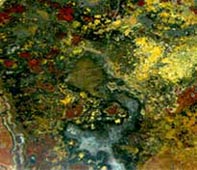
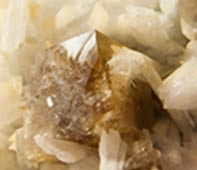
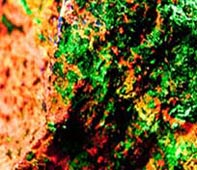
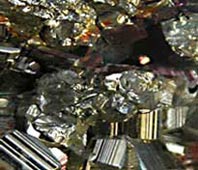
The Colors of Fluorescence, Part I
by Robert Beadle
From: The Pick and Dop Stick, 4/2013
4th Place — 2014 AFMS Original Adult Advanced Articles
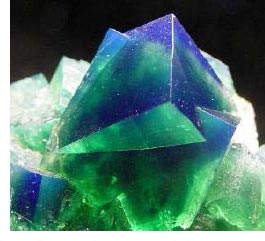
Fluorite crystals are a highly collectable mineral. I should know as I have been collecting fluorite since the start of my mineral collection. In addition to fluorite's many colors and crystal habits, it can fluoresce in a variety of colors, depending upon the trace impurities in its crystal structure.
For example, blue fluorescence in fluorite is typically caused by small amounts of europium replacing calcium in the crystal lattice. The best known blue fluorescing fluorites originate from the Cumberland and Weardale regions in England. Their bright blue fluorescence under long wave ultra violet light is perhaps the standard by which all others are judged. However, blue fluorescence in fluorite is not limited to England — it can be found all around the world. I own fluorites from China, Namibia, Morocco, Mexico, New Mexico, Tennessee, Kentucky, Alaska, Arizona, and southern Illinois. All of these locations have provided specimens that have fluoresced blue.(1)
Green, red, yellow, and cream-white colors are somewhat rarer, with white being the most abundant. Perhaps the best known cream-white fluorescent fluorites come from the Midwest. The quarries in Ohio and Iowa produce brown and purple cubes of fluorite that glow under both long and short wave ultraviolet light. They will phosphoresce, especially after exposure to short wave ultraviolet light. This phenomenon is caused by organic petroleum inclusions in the fluorite. It is interesting that the southern Illinois fluorites that do fluoresce because of petroleum or oil, glow a weak white-yellow. Some great producers of strong cream-white fluorescing fluorite are Pint's quarry in Iowa, Auglaise, Bluffton, Pugh and White Rock quarries in Ohio, to name a few.(1)
I'd like to categorize green fluorescence in fluorite into two types. Type 1 can be found in the rare variety of fluorite known as chlorophane — first found in Siberia, Russia.(2) Chlorophane is found in several locations around the world, including the United States with several sites in the eastern states. Chlorophane glows blue-green when its temperature rises. It also fluoresces under both long and short wave ultraviolet light. Phosphorescence is long, sometimes lasting for hours. In fact, chlorophane will phosphoresce after exposure to a table lamp.(3) The exact mechanism is not understood, but a combination of rare earth elements along with radiation damage to the crystal lattice is believed to cause these effects. Type 2 fluorites fluoresce green under short wave ultra violet light. The effect is caused by traces of uranium impurities in the fluorite. (4, 9) Two such specimens that I own are from Four Mile creek, near Canon City in Fremont Co., Colorado. They are botryoidal in structure, and colored grayish green. A third specimen with green fluorescence originates from Mexico. This specimen is almost botryoidal as well, and is colored a greenish yellow. I have a theory that fluorite formed at low temperatures can pick up traces of uranium. It is a well known fact that other low temperature crystalline minerals such as copal and agate tend to contain uranium as a constituent if it is available during formation. Interestingly, only one of my botryoidal fluorites from India fluoresces, and the color is blue. The specimen of botryoidal fluorite from Henan province in China is non-reactive to ultra violet light. As I only own a few of these India and China fluorites, no concrete conclusion may yet be drawn.
Yellow fluorescent fluorite is very rare. My research has found only a few locations around the world. These rare fluorites tend to occur in granite pegmatites enriched in rare earth elements.(6) Some of the classic, known localities are New Mexico and Norway.(5) I have found four new locations. They are: Un Sam mine, Hunan province in China(6), Yumate mine Okayama prefecture, Japan(7), Koss pit near Wausau, Marathon Co., Wisconsin, and a quarry on the south side of Sturgeon Bay, in Door Co., Wisconsin.(8)
Red fluorescence in fluorite is equally as rare as yellow. I know of only seven locations with fluorite that fluoresces red. Perhaps the most well known of these is Berber Asturias, Spain. The purple-violet cubes from this region glow cherry red upon exposure to long wave ultraviolet light.(1, 9) Red fluorescence in fluorite has also been reported from Celles, in the Namur province of Belgium.(11) A specimen of "Blue John", a type of banded fluorite from England, has exhibited a zone of red fluorescence. The location given was Treak Cliff near the Odin mine in Castletown, Derbyshire.(10) Mexico has three locations for this rare occurrence — Sonora,(4, 13) Ojuela mine in Mapini, Durango(14) and Mina El Tule Melchor Muzquiz, Coahuila.(9, 10) But of these fluorites, only a small percentage fluoresce blue, and an even smaller percentage fluoresce red. Our United States has two locations for red fluorescence in fluorite. The Burney mine in the Chinati mountains in Presidio Co., Texas has produced at least one specimen.(12) The other location is the Griffith mine in Harden Co., Illinois. Specimens from there may be non-fluorescent, blue fluorescent, red fluorescent, or even yellow with red fluorescent. It has been suspected that the rare earth elements europium along with samarium are responsible for red fluorescence. For the Griffith mine, iron dissolved in oil along with europium may be the cause.(15)
References:
1. Robert Beadle Collection
2. www.mindat.org
3. www.dirtyrockhounds.proboard.com
4. Extra Lapis English Fluorite, the Collectors Choice, Lithograpic llc.
5. Fluorescent Mineral Society, an international organization
6. www.Middleearthminerals.com
7. www.Springerlink.com
8. www.Wisconsingeologicalsurvey.org
9. Fluorescent Gems and Minerals under Ultraviolet Light, by Manuel Robbins
10. www.minersoc.org
11. www.fluomin.org
12. www.johnbetts.fineminerals.com
13. www.mineralatlas.com
14. www.kristauphe-gems.com
15. www.chicaogrocks.org (article Minerals of the IL/KY Fluorspar District, Part II, Robert Beadle)
For permission to reprint this article, contact us at info@chicagorocks.org.
